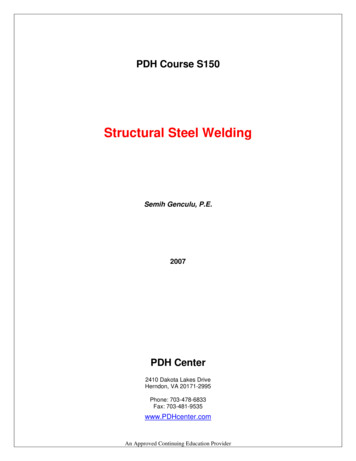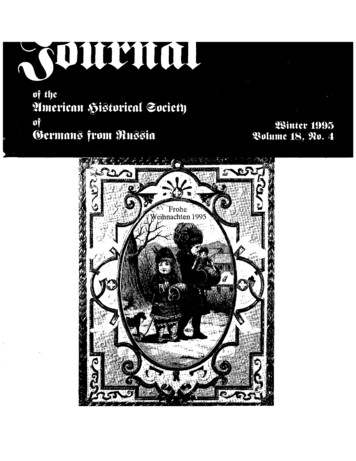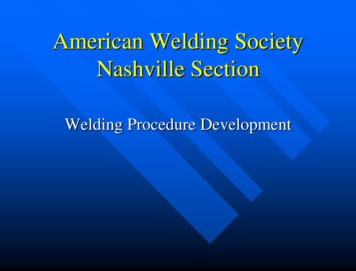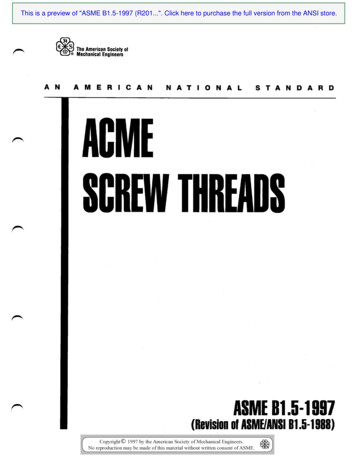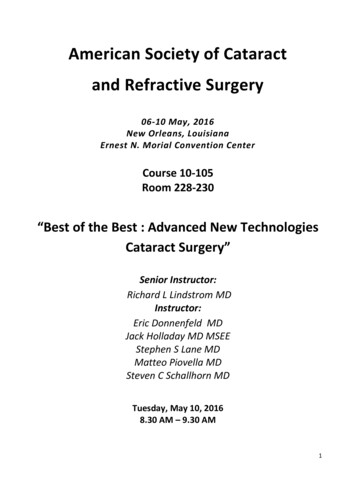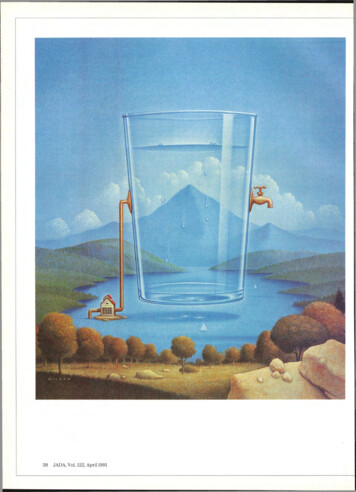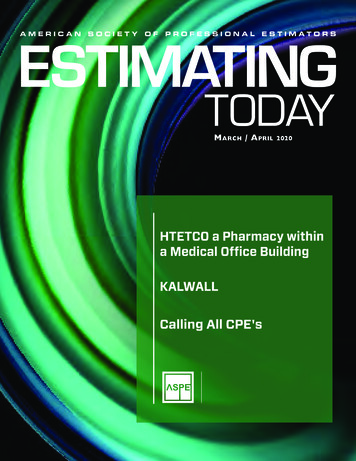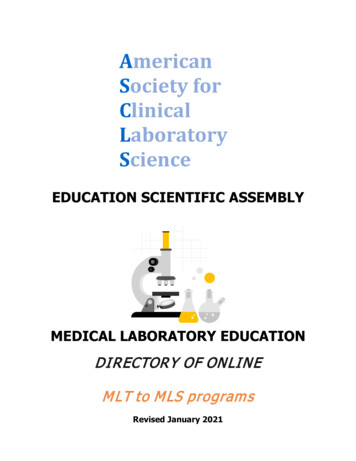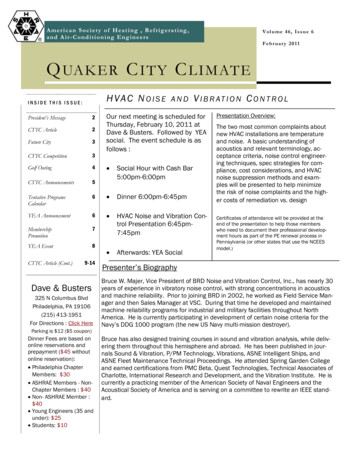
Transcription
A meri can S o ci et y o f H ea t i n g , Ref ri g erat i ng ,an d A i r -C o nd i ti o n in g En g i n eersV o l um e 4 6 , I s s ue 6F e br ua r y 2 0 1 1Q UAKER C ITY C LIMATEH VA C N O I S EINSIDE THIS ISSUE:President’s Message2CTTC Article2Future City3CTTC Competition3Golf Outing4CTTC Announcements5Tentative ProgramsCalendarANDV I B R AT I O N C O N T R O LOur next meeting is scheduled forThursday, February 10, 2011 atDave & Busters. Followed by YEAsocial. The event schedule is asfollows : Social Hour with Cash Bar5:00pm-6:00pm6 Dinner 6:00pm-6:45pmYEA Announcement6 MembershipPromotion7HVAC Noise and Vibration Control Presentation 6:45pm7:45pmYEA Event8 Afterwards: YEA SocialCTTC Article (Cont.)9-14Dave & Busters325 N Columbus BlvdPhiladelphia, PA 19106(215) 413-1951For Directions : Click HerePresentation Overview:The two most common complaints aboutnew HVAC installations are temperatureand noise. A basic understanding ofacoustics and relevant terminology, acceptance criteria, noise control engineering techniques, spec strategies for compliance, cost considerations, and HVACnoise suppression methods and examples will be presented to help minimizethe risk of noise complaints and the higher costs of remediation vs. designCertificates of attendance will be provided at theend of the presentation to help those memberswho need to document their professional development hours as part of the PE renewal process inPennsylvania (or other states that use the NCEESmodel.)Presenter’s BiographyBruce W. Majer, Vice President of BRD Noise and Vibration Control, Inc., has nearly 30years of experience in vibratory noise control, with strong concentrations in acousticsand machine reliability. Prior to joining BRD in 2002, he worked as Field Service Manager and then Sales Manager at VSC. During that time he developed and maintainedmachine reliability programs for industrial and military facilities throughout NorthAmerica. He is currently participating in development of certain noise criteria for theNavy’s DDG 1000 program (the new US Navy multi-mission destroyer).Parking is 12 ( 5 coupon)Dinner Fees are based ononline reservations andprepayment ( 45 withoutonline reservation): Philadelphia ChapterMembers: 30 ASHRAE Members - NonChapter Members : 40 Non- ASHRAE Member : 40 Young Engineers (35 andunder): 25 Students: 10Bruce has also designed training courses in sound and vibration analysis, while delivering them throughout this hemisphere and abroad. He has been published in journals Sound & Vibration, P/PM Technology, Vibrations, ASNE Intelligent Ships, andASNE Fleet Maintenance Technical Proceedings. He attended Spring Garden Collegeand earned certifications from PMC Beta, Quest Technologies, Technical Associates ofCharlotte, International Research and Development, and the Vibration Institute. He iscurrently a practicing member of the American Society of Naval Engineers and theAcoustical Society of America and is serving on a committee to rewrite an IEEE standard.
2010- 2011PresidentJohn Pardekooper, PEPresident-ElectBob FinkbonerVice PresidentJames Piscopo, PETreasurerJared Johnson, PESecretaryAshley LesterSenior GovernorP R E S I D E N T S M E S S AG E :The ASHRAE Philadelphia Chapter is off toa good start to the New Year. We had awell-attended social event in January at aFlyers game and have several upcomingevents in February. Our February 10th dinner meeting will bring us back to Daveand Busters, a venue with plenty of opportunities to network and socialize both before and after the dinner and presentation. I also encourage you to attend thebalancing seminar on February 26th thatis held at the Local 19 Sheet Metal Workers training center. This is a particularlyhelpful seminar for those of you looking tohave a better understanding of how theair and water sides of HVAC systems arebalanced.February 20-26 is Engineers Week andthere are a number of events here in theDelaware Valley during the week. Pleasetake a look at the Delaware Valley Engineers Week website for more details(www.dvec.org.)Best Regards,John Pardekooper215-436-5802c21@ashrae.netBill HartFan Balance and VibrationGovernorsAshley LesterMark Maguire, PEMike Witkowski, PENewsletter EditorMatthew TrinseyWeb Site EditorGary DebesSchool CoordinatorsJames Lill, PEJeff Crozier, PERefrigerationMatthew TrinseyStudent ActivitiesCommittee ChairMike Witkowski, PEMembership PromotionCommittee ChairJames Piscopo, PEEducation ChairMike Witkowski, PEPrograms Committee ChairBob FinkbonerChapter HistorianJared Johnson, PEYoung Engineers in ASHRAEAshley LesterThis article was submitted by Rob Innes of Mutimer Company on behalf of New York Blower. Articles highlightingnovel HVAC technologies should be submitted to Chapter Technology Transfer Committee Chair Mark Maguire(c021bog4@ashrae.net) for consideration in future newsletters.IntroductionVibration always has been a good indicator of how well a piece of equipment was designed, installedand maintained. With sophisticated, computerized, preventive maintenance programs, vibration cannow also be used as a precursor of future maintenance requirements.Fans are subject to vibration because they have a high ratio of rotating mass to total mass, and operate at relatively high speeds. Unlike most mechanical equipment, there are two major causes for vibration in fan equipment. These are aerodynamic (having to do with airflow) and mechanical (havingto do with rotating components, fasteners and structural support). This article will discuss both causesof vibration and provide guidelines for their reduction.Aerodynamic VibrationAerodynamic vibration occurs when a fan operates to the left of its peak static pressure point. Thevibration frequency is at a frequency other than the wheel rotation speed. This area of operation isillustrated in Figure 1. In this region the fan wheel does not move enough air to fill the blade passages. Aerodynamic vibration is most easily identified by increasing the volume of air flowing through thefan, thereby moving the fan’s point of operation to the right. If the cause is aerodynamic, the vibrationwill usually disappear or be reduced significantly. Increasing the airflow is accomplished by openingdampers, cleaning filters and coils, or as a test, removing a section of duct near the fan. These actionswill reduce system pressure and correspondingly, increase airflow.Because of their inherent wheel geometry, some fans are more susceptible to pulsation when operating to the left of the peak on their static pressure curve. Centrifugal fans utilizing forward-curved orflat, backwardly-inclinedblades are particularly subjectto this phenomenon. However, fans with backwardlyinclined airfoil blades are designed to be stable left-ofpeak.For the remainder of this article go to page 9.
P age 3Q ua k er Ci t y Cl i ma teV o l um e 4 6 , I s s ue 6Philadelphia Future City CompetitionOne outreach program of the National Engineers’ Week is the Future City competition. Teams of middle school students simulate their vision of a city of a future, develop an essay and an abstract, build a tabletop model and make a 7-minute presentation in a regional competition. Each team consists of an engineer/mentor, a teacher and three students.There were 40 middle-school entries in the 2011 Philadelphia regional competition, which was held January 22 at the SheetMetal Workers Union Hall.The regional competition winner advances to the national competition in Washington, DC during Engineers’ Week in February.The ASHRAE Philadelphia Chapter is a bronze-level sponsor of the program and awards the Best Indoor Environment Award tothe team which incorporates an innovative solution to controlling the indoor environment.The intent of the program is to steer young students toward engineering by associating the profession with an enjoyable competition. Thestudents also learn presentation, writing and team-building skills.St. Cecelia School from Philadelphia won the Best Indoor Environment Award. The team sited their city underwater and incorporateddesalination, a tidal energy plant and water purification by electrolysis. Buildings in the city were heated by ground-source heat pumps.ASHRAE Fellow John Kampmeyer is the regional coordinator for theevent. Chapter member Mark Maguire was a special-awards judge,and Jeff Crozier was a team mentor.The competition needs volunteers to sustain the effort on an ongoingbasis; please check their Website (futurecityphilly.org) for additionalpictures and volunteer opportunities.Chapter Technology Award Competition 2011The Technology Award Program recognizes members for innovative designs, communicate that technology to other members, and highlightachievements to other professionals.The Chapter Technology Transfer Committee will be accepting applications for the Chapter Level competition in March 2011 in the followingcategories: Commercial Buildings, New and ExistingInstitutional Buildings, New and ExistingHealth Care Facilities, New and ExistingIndustrial Facilities or Processes, New and ExistingPublic Assembly Facilities, New and ExistingResidential Buildings, New and Existing (Single Family and Multi-Family)Alternative or Renewable Energy UseEntries will be judged on energy efficiency, indoor air quality and thermal comfort, innovation, operation and maintenance, cost effectiveness, environmental impact and quality of presentation.The process for the ASHRAE Technology Awards starts right here at the Chapter level. Chapter Competition winners will be judged in theRegional Technology Award Competition. Regional winners will then submit a long form application for the Society Technology Award Competition. Winners of the Society Competition will also be featured in the ASHRAE Journal.More information on the Technology Award Program will be coming soon.Mark M. Maguire, PEChapter Chair – Technology Transferc021bog4@ashrae.net
ASHRAE PHILADELPHIA CHAPTERANNUAL GOLF TOURNAMENTFriday, June 3, 2011Northampton Valley Country Club299 Newtown-Richboro Road Richboro, PA 18954http://www.nvgc.com/Prizes to IncludeFirst Place Second Place Third Place Longest DriveClosest to the Pin Lunch/Registration: 12:00 PMShotgun Start: 1:00 PMFormat: ScrambleDinner/Awards: Following GolfPlease contact Jim Piscopo atjpiscopo@aeceng.net with any questionsSPONSORSHIP OPPORTUNITIESStay tuned.details will followREGISTRATION DETAILSStay tuned.details will follow
P age 5Q ua k er Ci t y Cl i ma teV o l um e 4 6 , I s s ue 6Chapter Technology Transfer CommitteeA S H R A E M I L T O N W.G A R L A N D A WA R DASHRAE offers two competition-based awardsencouraging the design of innovative refrigerationsystems. The Milton W. Garland CommemorativeRefrigeration Award for Project Excellence recognizes non-comfort refrigeration systems. The Refrigeration Comfort Cooling Award for Project Excellence is oriented toward comfort refrigerationsystems.The Philadelphia Chapter Technology TransferCommittee is currently accepting applications forboth competitions for 2011.The Garland Award competition is open for thedesign of mechanical refrigeration machinery forapplications other than human comfort: e.g., foodprocessing/preservation, industrial/manufacturingprocesses, life support in extreme environments,recreational facilities.The Refrigeration Comfort Cooling Award competition is open for the design of mechanical refrigeration machinery for human comfort applications.Both submissions must be made within 36 monthsof the initial operating date of the system, and willbe judged on the following criteria: Complexity of Problem Solution Concept Architectural Integration Originality Achievement of Performance Criteria Energy Effectiveness Budget ComplianceEase of MaintenanceAdditional information can be obtained from MarkMaguire, Chapter Transfer Technology Chair(c021bog4@ashrae.net).ASHRAE Offers Certification:Building Energy Assessment ProfessionalWith growing emphasis on energy consumption reduction and cost savings, there is a recognized need forcredible information to help in the assessment andmodeling of energy use in buildings.A new certification program from ASHRAE will help fillthat need, recognizing individuals’ ability to audit andanalyze residential, commercial and industrial buildings. The Building Energy Assessment Professional(BEAP) certification complements ASHRAE’s BuildingEnergy Quotient program as well as its Building Energy Modeling Professional certification. Together, theprograms provide a valuable toolkit when it comes tothe evaluation and reduction of building energy use.The BEAP program certifies individuals’ ability to auditand analyze residential, commercial, and industrialbuildings including determining project scope, collecting data, analyzing building performance, interpretingresults, evaluating alternatives, submitting recommendations for energy conservation measures, and assisting with the implementation of these recommendations.The program will launch February 2, 2011 with a penciland paper examination in conjunction with ASHRAE’s2011 Winter Conference and AHR Expo in Las Vegas.Approximately six weeks after the first exam administration, the exam for that program will be available oncomputer at proctored testing centers through AppliedMeasurement Professionals, Inc., which has testingcenters in Center City Philadelphia, Wilmington, DEand Robbinsville, NJ.This is in addition to the five certification programs currently available: Building Energy Modeling Professional; Healthcare Facility Design Professional;Commissioning Process Management Professional;High-Performance Building Design Professional;Operations and Performance Management Professional.Additional information is available on the ASHRAEWebsite at www.ashrae.org/certification. Or you canemail the Philadelphia Chapter Technology TransferChair (Mark Maguire) at c021bog4@ashrae.net.
Q ua k er Ci t y Cl i ma teP age 6V o l um e 4 6 , I s s ue 6P HI LA D
Bruce W. Majer, Vice President of BRD Noise and Vibration Control, Inc., has nearly 30 years of experience in vibratory noise control, with strong concentrations in acoustics and machine reliability. Prior to joining BRD in 2002, he worked as Field Service Man-ager and then Sales Manager at VSC. During that time he developed and maintained
